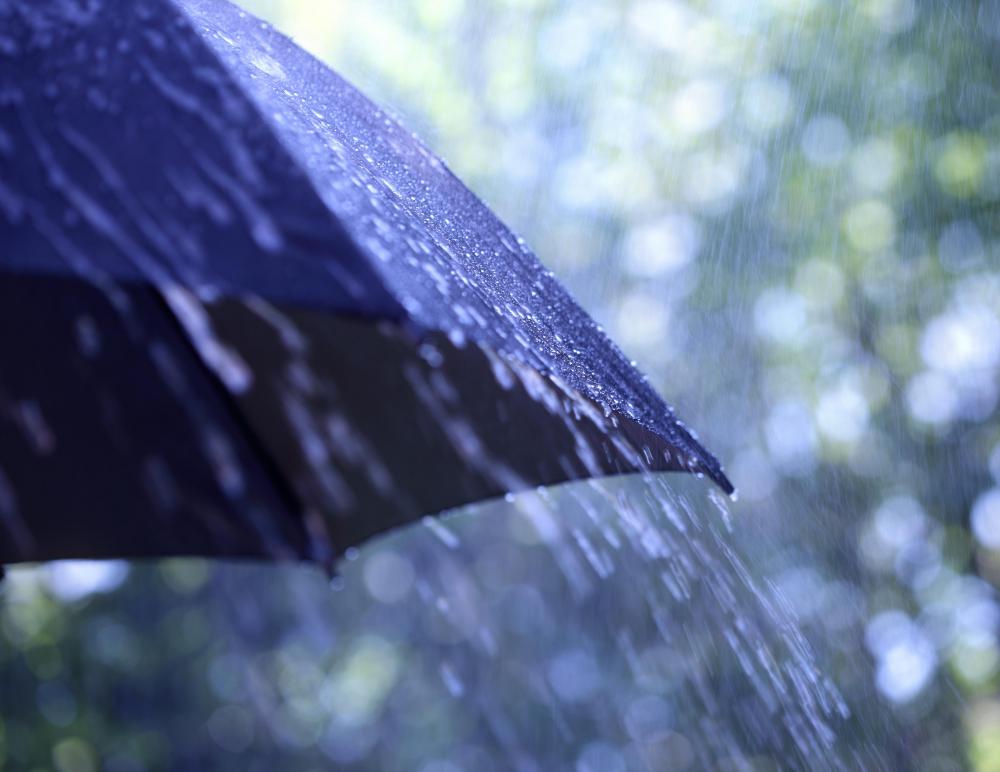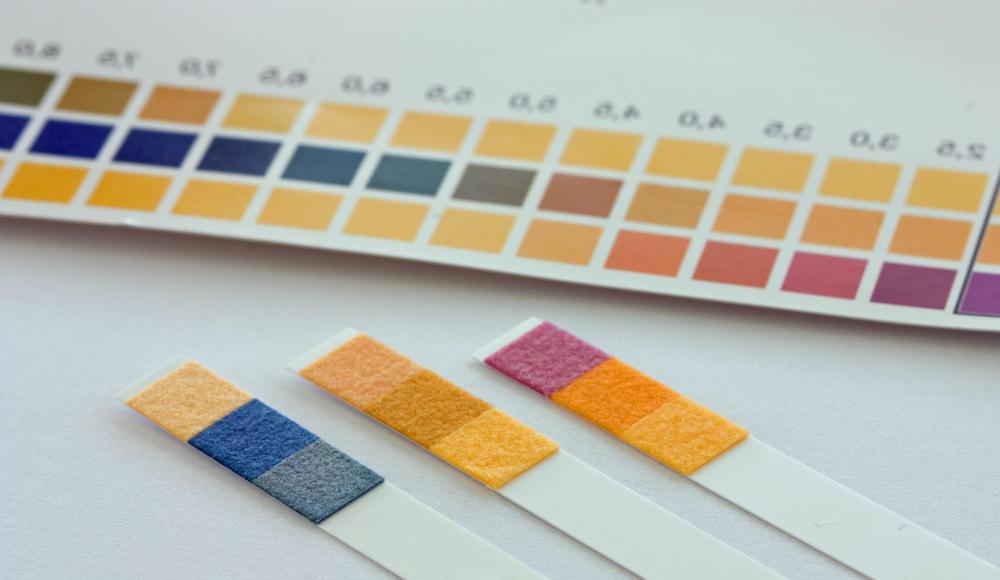At AllThingsNature, we're committed to delivering accurate, trustworthy information. Our expert-authored content is rigorously fact-checked and sourced from credible authorities. Discover how we uphold the highest standards in providing you with reliable knowledge.
What is Acid Rain?
Although the term acid rain was coined in the early 1850s, around the time of the Industrial Revolution, it didn't become a rallying cry for environmental reform until the late 1960s. The devastating effects of this precipitation on the world's water supply, fish populations, and plant life can be traced back scientifically to the use of fossil fuels in factories. Public demonstrations held in the early 1970s helped bring about major changes in pollution and emission standards. Although the problem still exists worldwide, many companies have taken steps to minimize its root causes.
Acid rain is precipitation that contains traces of pollutants, primarily sulfur dioxide and nitrogen oxide gases created as fossil fuels like coal or oil burn. Around the time of the Industrial Revolution, large factories began to use coal to power their machinery. As the coal burned, it released large amounts of sulfur and nitrogen gases into the air through smokestack exhaust. These gases would often reach the upper levels of the atmosphere and drift into areas where natural rainclouds regularly formed.

Particles of these highly acidic sulfur and nitrogen gases bond with the natural rain and fall to the ground during storms. Natural rainfall should have a pH level around 5.6, which is mildly acidic but not considered harmful. When sulfur dioxide and nitrogen oxide mixes with this rainwater, the pH level can quickly drop below 5.0. In certain areas located near large factories, the level occasionally approaches the acidity of pure vinegar. This is acid rain.

Acid rain does not always occur in the same area as the pollutants that cause it. Once the acidic pollutants leave the smokestack, they are caught up in the natural jet streams and weather fronts of the atmosphere. The sulfur and nitrogen gases might travel for a great distance before encountering rain-producing clouds.
In many cases, this precipitation is often more of a problem for neighboring countries than for those with the pollution-causing factories. Canada, for example, suffers effects of pollutants produced by factories located in New York and New Jersey. Scandinavian countries are plagued by acid rain originating from Russia and China.

The negative effects of acid rain can be seen everywhere. It can kill grasses and other protective ground cover, leading to more incidence of erosion and acidic soil levels. The precipitation can strip away the waxy coating on leaves, leaving trees more vulnerable to fungal damage and dehydration. Fish cannot survive or breed in water with a pH value below 5, which means that this pollution can kill off an entire population of fish.
It can also cause damage to exposed metal and concrete supports, grave markers and historical monuments, and damaged structures can be very costly to repair.

Following the stricter guidelines imposed by the Environmental Protection Agency (EPA), many factories in the United States have voluntarily installed special scrubbers to filter their emissions. These scrubbers use limestone and other basic chemicals to attract the sulfur particles before they leave the smokestack. In some cases, the resulting compound is sold to other companies as a form of gypsum, which is used to create drywall panels. Some nitrogen oxide still reaches the atmosphere, but it doesn't affect the pH level of rainfall as much as the sulfur dioxide once did.
Frequently Asked Questions
What exactly is acid rain?

Acid rain refers to a mix of wet and dry deposition from the atmosphere containing higher than normal amounts of nitric and sulfuric acids. It can result from both natural sources, like volcanoes, and man-made sources, primarily emissions of sulfur dioxide (SO2) and nitrogen oxides (NOx) resulting from fossil fuel combustion. Acid rain has a pH lower than the natural range of precipitation, which can harm ecosystems and man-made structures.
How does acid rain affect the environment?

Acid rain can have devastating effects on the environment. It can acidify water bodies, leading to the decline of aquatic life. Terrestrial ecosystems are not spared either; soil chemistry can be altered, nutrient availability can decrease, and toxic metals can be mobilized, all of which can lead to stressed vegetation and wildlife. According to the Environmental Protection Agency, acid rain has contributed to the decline of red spruce trees in the northeastern US.
What are the main causes of acid rain?

The primary causes of acid rain are emissions of sulfur dioxide (SO2) and nitrogen oxides (NOx) into the atmosphere, where they react with water, oxygen, and other chemicals to form acidic pollutants. These emissions largely come from burning fossil fuels in power plants, factories, and automobiles. The Clean Air Act has helped reduce SO2 and NOx levels in the U.S., but acid rain remains a concern due to both domestic and international sources.
Can acid rain affect human health?

While acid rain does not directly harm human health, the pollutants that cause acid rain—sulfur dioxide (SO2) and nitrogen oxides (NOx)—can lead to respiratory problems, including asthma and bronchitis. Moreover, the fine particles associated with these pollutants can penetrate deep into the lungs, posing additional health risks. The EPA has linked long-term exposure to these pollutants with increased risk of heart and lung disorders.
Is acid rain still a problem today?
Yes, acid rain is still a problem, although its severity has decreased in some regions due to stricter air quality regulations. For instance, the Acid Rain Program under the Clean Air Act Amendments of 1990 in the United States has led to significant reductions in SO2 and NOx emissions. However, in parts of Asia and Eastern Europe, acid rain continues to be a significant environmental issue due to ongoing industrial emissions.
What can be done to reduce acid rain?
To reduce acid rain, we must cut down on the emissions of sulfur dioxide and nitrogen oxides. This can be achieved by using cleaner forms of energy, such as solar and wind, increasing energy efficiency, and utilizing technologies like flue-gas desulfurization in power plants. Additionally, international cooperation and regulations, similar to the Clean Air Act in the U.S., are crucial for addressing transboundary pollution contributing to acid rain.
AS FEATURED ON:
AS FEATURED ON:


















Discussion Comments
@ysmina- Well, it's not going to eat away at your skin. If you drink water contaminated with acid rain on the other hand, it is very bad for health. At least we have systems to filter and purify water. A lot of animals in nature do drink rain water when they're thirsty. That can't be good, it probably damages their organs.
Acid rain ruins everything, especially cars. Both of our cars have spots on the paint because of acid rain. It's not easy to fix either, I will have to pay a lot of money to have those spots re-painted.
When people are exposed to acid rain, what kind of an affect does it have on them?
When I think of acid rain, I think of an extremely dangerous rain that would burn people's skin when it comes into contact with it. I must have gotten this idea from sci-fi and horror films.
But what kind of an effect does acid rain have on our health in general? Is it as bad for us as it is for plants and fish?
@ Fiorite- I saw a program about cave diving the other day and I learned that hard water is the result of acid rain dissolving limestone. The acid rain is a weak form of carbonic acid, and when it reacts with the limestone, it forms calcium bicarbonate (an aqueous solution). The calcium bicarbonate solution enters the ground water and comes out your shower faucet. When heated, the water evaporates, the carbon dioxide gas dissipates, and all that is left is the carbonate, which forms a ring around the tub. Interesting to know that my hard water is caused by millions of years’ worth of sedimentary rock being dissolved by acid rain.
I saw an acid rain television program (national geographic I think) that said acid rain was largely responsible for the decline in the number of California condors, bald eagles, and other raptor declines. The acid rain, combined with the ingestion of toxic chemicals from coal plant smoke stacks, lead to softer eggshells in these predatory birds. This greatly decreased the population of these birds in the wild.
They are beginning to increase in number now. This is largely due to the clean air act, and the ensuing reduction in air pollution. During the '90s and the first decade of this millennium, the numbers of falcons, bald eagles and other raptors has risen. These animals are beginning to work their way back from the edge of extinction.
Post your comments